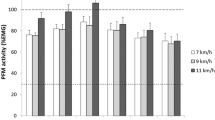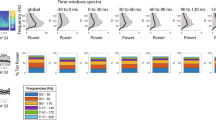Abstract
Introduction and hypothesis
The prevalence of female stress urinary incontinence is high, and young adults are also affected, including athletes, especially those involved in “high-impact” sports. To date there have been almost no studies testing pelvic floor muscle (PFM) activity during dynamic functional whole body movements. The aim of this study was the description and reliability test of PFM activity and time variables during running.
Methods
A prospective cross-sectional study including ten healthy female subjects was designed with the focus on the intra-session test–retest reliability of PFM activity and time variables during running derived from electromyography (EMG) and accelerometry.
Results
Thirteen variables were identified based on ten steps of each subject: Six EMG variables showed good reliability (ICC 0.906–0.942) and seven time variables did not show good reliability (ICC 0.113–0.731). Time variables (e.g. time difference between heel strike and maximal acceleration of vaginal accelerator) showed low reliability. However, relevant PFM EMG variables during running (e.g., pre-activation, minimal and maximal activity) could be identified and showed good reliability.
Conclusion
Further adaptations regarding measurement methods should be tested to gain better control of the kinetics and kinematics of the EMG probe and accelerometers. To our knowledge this is the first study to test the reliability of PFM activity and time variables during dynamic functional whole body movements. More knowledge of PFM activity and time variables may help to provide a deeper insight into physical strain with high force impacts and important functional reflexive contraction patterns of PFM to maintain or to restore continence.

Similar content being viewed by others
References
Botlero R, Davis SR, Urquhart DM, Shortreed S, Bell RJ (2009) Age-specific prevalence of, and factors associated with, different types of urinary incontinence in community-dwelling Australian women assessed with a validated questionnaire. Maturitas 62:134–139
Brown SJ, Donath S, MacArthur C, McDonald EA, Krastev AH (2010) Urinary incontinence in nulliparous women before and during pregnancy: prevalence, incidence, and associated risk factors. Int Urogynecol J 21:193–202
Bø K (2004) Urinary incontinence, pelvic floor dysfunction, exercise and sport. Sports Med 34:451–464
Carls C (2007) The prevalence of stress urinary incontinence in high school and college-age female athletes in the Midwest: implications for education and prevention. Urol Nurs 27:21–24
Simeone C, Moroni A, Pettenò A et al (2010) Occurrence rates and predictors of lower urinary tract symptoms and incontinence in female athletes. Urologia 77:139–146
Eliasson K, Larsson T, Mattsson E (2002) Prevalence of stress incontinence in nulliparous elite trampolinists. Scand J Med Sci Sports 12:106–110
Salvatore S, Serati M, Laterza R, Uccella S, Torella M, Bolis PF (2009) The impact of urinary stress incontinence in young and middle-age women practising recreational sports activity: an epidemiological study. Br J Sports Med 43:1115–1118
Eliasson K, Edner A, Mattsson E (2008) Urinary incontinence in very young and mostly nulliparous women with a history of regular organised high-impact trampoline training: occurrence and risk factors. Int Urogynecol J 19:687–696
Shishido K, Peng Q, Jones R, Omata S, Constantinou CE (2008) Influence of pelvic floor muscle contraction on the profile of vaginal closure pressure in continent and stress urinary incontinent women. J Urol 179:1917–1922
Deffieux X, Hubeaux K, Porcher R, Ismael SS, Raibaut P, Amarenco G (2008) Abnormal pelvic response to cough in women with stress urinary incontinence. Neurourol Urodyn 27:291–296
Morin M, Bourbonnais D, Gravel D, Dumoulin C, Lemieux MC (2004) Pelvic floor muscle function in continent and stress urinary incontinent women using dynamometric measurements. Neurourol Urodyn 23:668–674
Miller J, Kasper C, Sampselle C (1994) Review of muscle physiology with application to pelvic muscle exercise. Urol Nurs 14:92–97
Hodges PW, Sapsford R, Pengel LHM (2007) Postural and respiratory functions of the pelvic floor muscles. Neurourol Urodyn 26:362–371
Sjödahl J, Kvist J, Gutke A, Öberg B (2009) The postural response of the pelvic floor muscles during limb movements: a methodological electromyography study in parous women without lumbopelvic pain. Clin Biomech 24:183–189
Zadpoor AA, Nikooyan AA (2011) The relationship between lower-extremity stress fractures and the ground reaction force: a systematic review. Clin Biomech 26:23–28
Keller TS, Weisberger AM, Ray JL, Hasan SS, Shiavi RG, Spengler DM (1996) Relationship between vertical ground reaction force and speed during walking, slow jogging, and running. Clin Biomech 11:253–259
Merletti R, Parker PJ (2004) Electromyography: physiology, engineering, and non-invasive applications. Wiley, New Jersey
Grape HH, Dedering Å, Jonasson AF (2009) Retest reliability of surface electromyography on the pelvic floor muscles. Neurourol Urodyn 28:395–399
Weir JP (2005) Quantifying test-retest reliability using the intraclass correlation coefficient and the SEM. J Strength Cond Res 19:231–240
Portney LG, Watkins MP (2009) Foundations of clinical research: applications to practice, 3rd edn. Pearson/Prentice Hall, Upper Saddle River
Enck P, Vodušek DB (2006) Electromyography of pelvic floor muscles. J Electromyogr Kinesiol 16:568–577
Gollhofer A, Horstmann GA, Schmidtbleicher D, Schönthal D (1990) Reproducibility of electromyographic patterns in stretch-shortening type contractions. Eur J Appl Physiol 60:7–14
Schulte-Frei B (2006) Sport- und Bewegungstherapie für den weiblichen Beckenboden. Alltagsrelevanz, Analyse und Therapie unter besonderer Berücksichtigung der neuromuskulären Ansteuerung. Dissertation, Institut für Rehabilitation und Behindertensport der Deutschen Sporthochschule Köln
Leitner M, Schmid S, Hilfiker R, Radlinger L (2011) Test-retest reliability of vertical ground reaction forces during stair climbing in the elderly population. Gait Posture 34:421–425
Masani K, Kouzaki M, Fukunaga T (2002) Variability of ground reaction forces during treadmill walking. J Appl Physiol 92:1885–1890
Bø K, Sherburn M (2005) Evaluation of female pelvic-floor muscle function and strength. Phys Ther 85:269–282
Maurer C, Federolf P, von Tscharner V, Stirling L, Nigg BM (2012) Discrimination of gender-, speed-, and shoe-dependent movement patterns in runners using full-body kinematics. Gait Posture 36:40–45
Wright IC, Neptune RR, van den Bogert AJ, Nigg BM (1998) Passive regulation of impact forces in hell-toe running. Clin Biomech 13:521–531
Acknowledgements
The authors thank Parsenn-Produkte AG (Küblis, Switzerland) for providing the vaginal surface EMG probes.
Conflicts of interest
None
Author information
Authors and Affiliations
Corresponding author
Rights and permissions
About this article
Cite this article
Luginbuehl, H., Greter, C., Gruenenfelder, D. et al. Intra-session test–retest reliability of pelvic floor muscle electromyography during running. Int Urogynecol J 24, 1515–1522 (2013). https://doi.org/10.1007/s00192-012-2034-2
Received:
Accepted:
Published:
Issue Date:
DOI: https://doi.org/10.1007/s00192-012-2034-2




